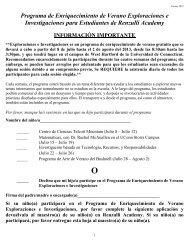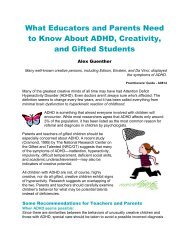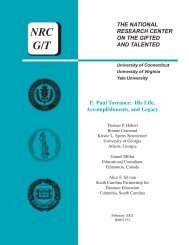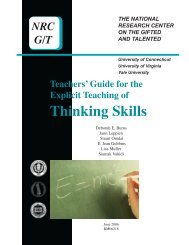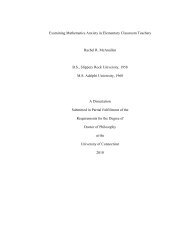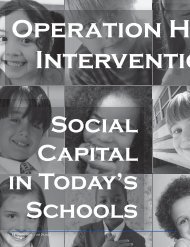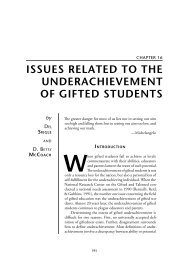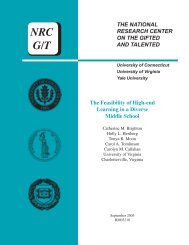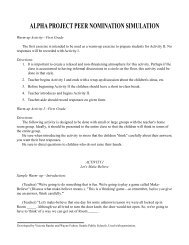Giftedness and High School Dropouts - Neag Center for Gifted ...
Giftedness and High School Dropouts - Neag Center for Gifted ...
Giftedness and High School Dropouts - Neag Center for Gifted ...
Create successful ePaper yourself
Turn your PDF publications into a flip-book with our unique Google optimized e-Paper software.
6<br />
To obtain a more precise estimate of dropout rates, the terms dropout <strong>and</strong> dropout<br />
rates should be clearly defined. National <strong>Center</strong> <strong>for</strong> Education Statistics (1997) provided<br />
three different types of dropout rates, as follows:<br />
Event rates describe the proportion of students who leave high school each year<br />
without completing a high school program. Offering an annual measure of recent<br />
dropout occurrences, event rates can provide important in<strong>for</strong>mation about how<br />
effective educators are in keeping students enrolled in school.<br />
Status rates provide cumulative data on dropouts among all young adults within a<br />
specified age range. Generally, status rates are much higher than event rates<br />
because they include all dropouts regardless of when they last attended school.<br />
Since status rates reveal the extent of the dropout problem in the population, this<br />
rate also can be used to estimate the need <strong>for</strong> further education <strong>and</strong> training that<br />
will help dropouts participate fully in the economy <strong>and</strong> life of the nation.<br />
Cohort rates measure what happens to a cohort of students over a period of time.<br />
This rate is based on repeated measures of a group of students with shared<br />
experiences, <strong>and</strong> reveals how many students starting in a specific grade dropout<br />
over time. Typically, cohort rates from longitudinal studies provide more<br />
background <strong>and</strong> contextual data on the students who drop out than are available<br />
through the CPS or CCD data Collections. (p. 4)<br />
Factors Related to the <strong>High</strong> <strong>School</strong> <strong>Dropouts</strong><br />
Various research approaches <strong>and</strong> theoretical models have been proposed <strong>for</strong><br />
studying the personal, educational, <strong>and</strong> psychological variables that cause the high school<br />
student to drop out. Robertson (1991) indicated that previous studies reported several<br />
common characteristics of high school dropouts: minority group, low socioeconomic<br />
status, limited ability to speak English, <strong>and</strong> low academic ability. Similarly, from the<br />
analysis of "<strong>High</strong> <strong>School</strong> <strong>and</strong> Beyond" data, Ekstrom, Goertz, Pollack, <strong>and</strong> Rock (cited in<br />
Marquardt, 1987) found the following characteristics of high school dropouts:<br />
1. <strong>Dropouts</strong> were disproportionately from low socioeconomic status<br />
families <strong>and</strong> racial/ethnic minority groups.<br />
2. Compared to "stayers," dropouts came more from homes lacking in<br />
support <strong>for</strong> education, including fewer study aids, less likely to<br />
have both natural parents at home, mothers who were working <strong>and</strong><br />
had both lower levels of education <strong>and</strong> lower expectations <strong>for</strong><br />
offspring, <strong>and</strong> parents less likely to express interest in or monitor<br />
school activities.<br />
3. <strong>Dropouts</strong> had lower school grades, lower test scores, did less<br />
homework, <strong>and</strong> reported more disciplinary problems than<br />
"stayers."




